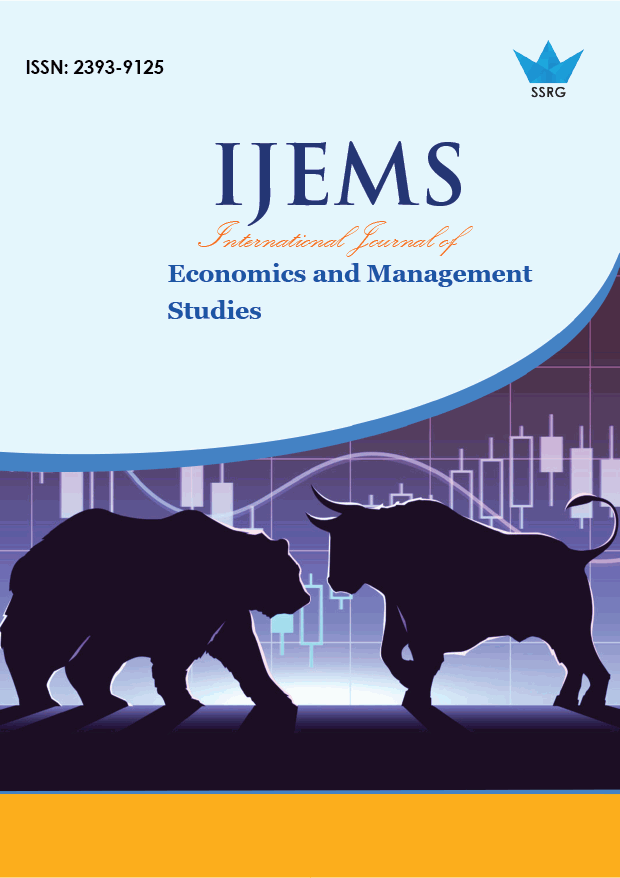Customer Purchase Intention on Counterfeit Fashion Products: Application of Theory of Reasoned Action

| International Journal of Economics and Management Studies |
| © 2020 by SSRG - IJEMS Journal |
| Volume 7 Issue 10 |
| Year of Publication : 2020 |
| Authors : Mochammad Ferisqo Satya Negara, Mahrinasari MS, Dorothy Rouly |
How to Cite?
Mochammad Ferisqo Satya Negara, Mahrinasari MS, Dorothy Rouly, "Customer Purchase Intention on Counterfeit Fashion Products: Application of Theory of Reasoned Action," SSRG International Journal of Economics and Management Studies, vol. 7, no. 10, pp. 105-108, 2020. Crossref, https://doi.org/10.14445/23939125/IJEMS-V7I10P116
Abstract:
Fashion is a popular aesthetic expression at a particular time and place and in a specific context, especially in clothing, footwear, lifestyle, accessories, makeup, hairstyle, and body proportions. In Indonesia, counterfeit fashion products is a phenomenon that is currently happening. To find out the reasons why people intend to buy counterfeit fashion products, this study adopts the Theory of Reasoned Action (TRA) by taking social factors, which consist of information susceptibility and normative susceptibility, as well as personal factors, which consist of value consciousness, perceived risks, integrity, consumption status, and materialism as variables in this study.
This study examines whether attitudes mediate social factors and personal factors on consumer purchase intentions in buying counterfeit fashion products. The data used are primary. The data collection technique was used through a questionnaire. This study's population knew about counterfeit fashion products, while the sampling technique used purposive sampling of 200 respondents.
The results showed that attitudes mediate normative susceptibility, value consciousness, integrity, consumption status, and materialism to purchase intention. And it does not mediate normative susceptibility and perceived risk to purchase intentions.
Keywords:
theory of reasoned action, attitudes, purchase intention, counterfeit
References:
[1] Ajzen, I., & Fishbein, M. (1980). “Understanding attitudes and predicting social behaviour”. NJ: Prentice-Hall.
[2] De Matos, C. A., Ituassu, C. T., & Rossi, C. A. V. (2007). “Consumer attitudes toward counterfeits: A review and extension”. Journal of Consumer Marketing, 24(1), 36-47.
[3] Engel, James. F, Roger D. Blackwell & Paul W. Miniard. (2002). Perilaku Konsumen, Edisi Keenam, Jilid 1, Jakarta: Binarupa.
[4] Fernandes, Cedwyn. (, 2013). “Analysis of Counterfeit Fashion Purchase Behaviour in UAE”, Journal of Fashion Marketing and Management: An International Journal, Vol. 17 Iss 1 pp. 85 – 97
[5] Ghozali, Imam. (2011). “Aplikasi Analisis Multivariate Dengan Program SPSS. Edisi Keempat”. Semarang: Badan Penerbit Universitas Diponegoro.
[6] Hair, J.F., Anderson, R.E., Tatham, R.L and Black, W.C. 2007. “Multivariate Data Analysis”. Sixth Edition. UK: Prentice-Hall International.
[7] Kim, H., & Karpova, E. (2010). “Consumer attitudes toward fashion counterfeits: Application of the theory of planned behaviour”. Clothing & Textile Research Journal, 28(2), 79-94
[8] Suharto, Durotun Nasikah, "The Effect of Celebrity Endorsement and Trust on Purchasing Decisions" SSRG International Journal of Economics and Management Studies 7.3 (2020): 72-77.
[9] Kotler, Philip dan Kevin Lane Keller, 2009, Manajemen pemasaran, Edisi 13 Jilid. 1. Jakarta
[10] Kotler, Philip dan Amstrong, Gary. 2011. Manajemen Pemasaran. Edisi 11. Jilid 1. Jakarta : PT.Index Kelompok Gramedia.
[11] Marticotte, François dan Manon Arcand. 2017. “Schadenfreude, attitude, and the purchase intentions of a counterfeit luxury brand”. Journal of Business Research Volume 77, p. 175-183
[12] Nazir, Mohammad. 2009. Metode Penelitian. Jakarta: Ghalia Indonesia.
[13] Phau, I., & Teah, M. (2009). “The devil wears (counterfeit) Prada: A study of antecedents and attitudes towards counterfeits of luxury brands”. Journal of Consumer Marketing, 26(1), 15-27.
[14] Ramayah, T., Jantan, M., Chow, J. L. W., & Nasirin, S. (2004). “Counterfeit music CDs: Social and personality influences, demographics, attitudes, and purchase intention: Some insights from Malaysia” (pp. 1e13). In Academic Conferences Limited.
[15] Shimp, Terence. 2014. “Komunikasi Pemasaran Terpadu dalam periklanan dan Promosi”. Jakarta: Salemba Empat
[16] Solomon, Michael R. (2011). “Consumer Behavior : Buying, Having and Being”, 9th ed.,. New Jersey: Pearson Addison Wesley
[17] Sugiyono. 2014. Metode Penelitian Kuantitatif, Kualitatif, dan R & D. Alfabeta : Bandung.
[18] Ting, M., Goh Y., dan Salmi M. Isa. 2016. “Determining consumer purchase intentions toward counterfeit luxury goods in Malaysia”. Asia Pacific Management Review, Vol. 21 Issue 4
[19] Wang, F., Zhang, H., Zang, H., & Ouyang, M. (2005). “Purchasing pirated software: An initial examination of Chinese consumers”. Journal of Consumer Marketing, 22(6), 340-351.

 10.14445/23939125/IJEMS-V7I10P116
10.14445/23939125/IJEMS-V7I10P116